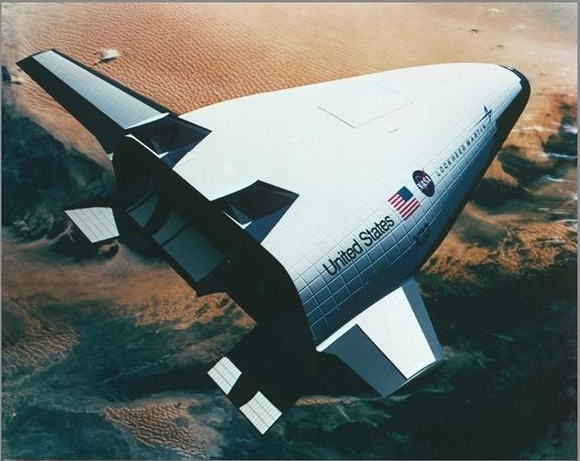






Selected Articles from the
March 2001 Odyssey
Editor: Terry Hancock
- Scorpius Team Files Again, Steve Bartlett
- The Demise of X-33 and X34, Steve Bartlett
- Opening Space: The SpaceLift Project, Terry Hancock
- The Surf Report, Diane Rhodes
The Demise of X-33 and X-34: The End of Reusable Launch Vechicles?
By Steve Bartlett
In early March, NASA announced that it was canceling the X-33 and X-34 reusable launch vehicle (RLV) technology demonstration programs. The reasons given for the cancellation were excessive cost overruns and technical hurdles. Both programs were intended to develop the technology to dramatically reduce the price of space launch from the current $4,000 to $10,000 per pound of payload to below $1,000 per pound. With the demise of these programs, there will be no viable replacement to the Shuttle in the foreseeable future and the cost of space launch will continue to serve as a major hurdle to expanding human exploration and development of space.
The X-33 and X-34 test rockets were intended to prove out the technologies needed for single-stage-to-orbit capability. These technologies included high performance engines; lightweight composite propellant tanks and structures; advanced, robust thermal protection schemes; autonomous vehicle control and self-diagnostics; and simplified flight operations. In the end, NASA and its contractors found that developing these technologies and integrating them into flight vehicles while keeping within their program budgets exceeded their management and technical abilities.
 |
| Artist's rendering of X-33 (NASA/Locheed Martin) Click here to enlarge. |
Members of the space activist community have suggested that NASA's development of RLV's was preventing private firms from building their own reusable rockets. Those activists have stated that government involvement in such efforts put the government in direct competition with private firms for putting up satellites, thus frightened away potential investors. They have expressed the opinion that if the government ``got out of the way'' that there would be dozens of firms vying to build and fly RLV's.
Such positions ignore certain fundamental facts about the technical and financial problems associated with developing RLV's. Technically, RLV's must be built to be very lightweight and have high performance engines and other systems just to achieve orbit. This generally means complex systems, small design margins, extensive testing, and high costs.
To ensure that the craft can reliably and repeatably reach orbit and deploy payloads, they have to be built with significant redundancy and structural robustness, comparable to a modern airliner. But such redundancy and robustness requires putting additional weight into a vehicle. This added weight must be taken out of the rocket elsewhere, either from its structure or from the deliverable payload. This adds further complexity and cost to the vehicle.
RLV's are expensive systems by their very nature to develop, operate, and maintain. An RLV or fleet of RLV's must fly frequently enough and capture enough of the launch market to pay back its development cost and turn a profit for its investors in a reasonable time. The best estimates for financing such a venture assume 4-6 rockets in a fleet, each flying every two weeks for 7-10 years, charging approximately $1,000 per pound of payload, and having a development cost of approximately $1 billion per rocket.
Development costs of this magnitude, the uncertain launch market, and the 10-15 year payback times associated with RLV fleets severely limit the number of firms willing to finance such a venture. This is particularly true in the current financial climate, where investors are more concerned about returns in the next fiscal quarter than several years down the line. The recent failures of such well-financed firms as Iridium and ICO Global have also soured investors on large space efforts.
In short, without government involvement of some sort, either through direct development of the vehicles or launch guarantees, it is highly unlikely that any firm will develop an RLV anytime soon. This makes the cancellation of X-33 and X-34 of serious concern. These projects were focused on specific goals using flying testbeds, an approach that has worked very well in moving technology out of the laboratory and into the skies. We can only hope that RLV's don't slip back into the ``permanent research project'' status that they held for so many years. The opportunity to reap great returns for the American people and, eventually, for numerous private firms exists once RLV's have been shown to work. Now is the time to seize that opportunity.
Also see Steve Bartlett's article Reusable Launch Vehicles Coming Together in Palmdale from the July 1999 issue of the Odyssey. Readers may also wish to search the OASIS Web Site for X-33 and X-34.
File translated from TEX by TTH,
version 2.25.
On 31 Mar 2001, 14:54.
Copyright © 1998-2003 Organization for the Advancement of Space Industrialization and Settlement. All Rights Reserved.